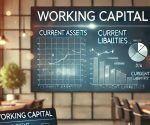Revenue expenditure is merely the costs that businesses incur for the regular operation and maintenance within a short period. These costs are the bloodstreams of companies but do not add to the corpus or improve long-term fixed assets. Unlike capital expenses incurred for the long-term investment made on machinery or land, salary, rent, utilities, and repair costs relate to revenue expenditure. Therefore, every company must understand revenue expenditure for better budgeting, profit calculation, taxation, and overall financial planning. This article will explain types of revenue expenditure, formulae, importance, and key differences between revenue and capital expenditure, but in real-life examples to make it easy to understand.
What is Revenue Expenditure?
Revenue expenditures are money spent by an organization in the work it does day to day to sustain current operations. These expenditures are all consumed within the relevant accounting period and do not create or improve long-term assets. Instead, these expenditures assure the proper functioning of core business processes such as production, administration, sales, and delivery. Revenue expenditure involves salaries, the purchase of raw materials, the payment of power bills and equipment repairs related to daily business operations. These expenses are deducted in their entirety from revenues in the profit and loss account of the relevant financial period, thus determining the profitability of that period.
Key Components of Revenue Expenditure
Revenue expenditure is not fixed against a precise mathematical formula; it is conceptualized mainly as all recurring costs incurred by a business for operations in a given year. Such costs create an expenditure on the income statement that reduces an enterprise’s yearly amount for profit. Understanding the makeup of revenue expenditure aids in budget formulation and the assessment of financial performance.
Operating Costs
For the entire period of existence of any business, there will be an operational cost maintained. They include things like rent for maintaining working space, salaries for employees, expenses for insurance, purchase of office supplies, and various administrative costs. General operational costs are those that the business cannot avoid for general operations to run smoothly; it has to incur some costs.
Though any company might be required to pay for the services, higher costs are incurred for their maintenance. To that extent, some expenses surely accrue in a company. For example, general operational costs are called these costs on which a company would manage to incur expenditures without a break; there would have to be some expenditure incurred by the company toward its common operational activities.
Maintenance Costs
These costs help preserve existing business assets like machinery, buildings, and vehicles. They do not enhance or upgrade assets but keep them in working condition. For instance, fixing a leaking pipe or repainting office walls would be classified as maintenance costs.
Labor Costs
Wages, salaries, employee benefits, and overtime payments fall under labor costs. Since a company needs its workforce to function daily, labor is a core revenue expenditure component. This category also includes payroll taxes and bonuses.
Utility Costs
Electricity, water, gas, telephone, and internet bills paid for utilities come under revenue expenditure charges. These costs are normally considered indirect in their true nature, but are considered as crucial for the day-to-day running of the business, productivity of its employees, or customer service.
Cost Of Raw Materials
The cost of raw materials used directly in the production process is considered an expense. Wood for furniture or flour for baking are vital operating inputs that are always treated as revenue expenditure.

Revenue Expenditure Types with Practical Examples
Revenue expenditures may also be classified according to their function or department in the firm’s structure. These types allow management to better track spending in line with fulfilling appropriate resource behavior. The important categories of revenue expenditure are listed below.
Operating Expenses
Operating expenses are the most common form of revenue expenditure. They include routine costs required to run the core business—rent, wages, office supplies, and internet bills—and are essential for continuously delivering products and services.
Repairs and Maintenance
These costs ensure existing business assets remain in working order. While they do not increase the life or value of an asset, they help avoid major breakdowns. For instance, fixing a faulty air conditioning unit in the office or servicing factory machinery qualifies as maintenance expenditure.
Selling and Distribution Expenses
These expenses help businesses reach customers and fulfill sales. They include advertising costs, sales commissions, packaging, shipping, and freight charges. Without selling and distribution costs, companies could not promote their products or deliver them to buyers.
Administrative Expenses
Administrative expenses are all indirect costs related to general management that are not linked to production or sales. Examples include office rent, legal fees, audit charges, and HR or finance staff salaries. Administrative costs help keep a business’s internal structure orderly and compliant.
Financial Expenditure
Interest on a loan, processing fees, or bank charges can be found on this kind of expense. Financial expenses are the costs incurred in borrowing money or in conducting financial operations. Although these do not physically enter the operations of the company, they will have a severe impact on net profits and cash flow.
Importance of Revenue Expenditure in Business Operations
Revenue expenditures are important in providing rhythm and health in the company’s functioning and money matters. No business can run efficiently without these recurring investments. They are closely monitored and managed within an organization to ensure that everything works properly and profits are made.
Secures Business Continuity
Salaries, maintenance, and utilities regularly keep the business running without interruption. If not paid on time, disruptions, alarming employee conditions, or operational failures will arise, falling short of ideal productivity and customer satisfaction.
Tighter Cost Control
Companies constantly track revenue and expenditures to forecast and manage operating budgets. Thus, they can minimize unnecessary spending by tracing actual costs against projected ones and directing them toward the last line of control.
Direct Impact on Profitability
Since revenue expenditure is deducted from revenue to calculate profit, even minor overspending can affect net income. Managing operational costs effectively is one of the easiest ways to improve profitability without increasing revenue.
Tax Benefits and Deductions
Revenue expenditures are generally tax-deductible, helping businesses reduce their taxable income. This legal tax shield improves a company’s cash position and supports reinvestment in the business.
Supports Financial Planning
When organizations understand recurring expenses, they can prepare cash flow statements accurately, budget efficiently, and set realistic financial goals. Revenue expenditure forecasts also ensure the firm has enough liquidity to sustain daily activity.
Difference Between Revenue and Capital Expenditure
Knowing how to distinguish between revenue and capital expenditure is key to maintaining accurate financial records. Accounting treats these expenses differently and has distinct impacts on financial statements.
| Criteria | Revenue Expenditure | Capital Expenditure |
| Nature of Expense | Recurring, short-term operational costs | One-time, long-term investment in assets |
| Financial Statement Impact | Affects the profit & Loss account | Recorded as assets on the Balance Sheet |
| Benefit Duration | Short-term, used within the current period | Long-term, used over several years |
| Examples | Salaries, utilities, raw materials, repairs | Purchase of land, buildings, equipment |
| Tax Treatment | Fully tax-deductible in the same year | Depreciated or amortized over the asset life |
Revenue Expenditure FAQs
1. What is the accounting definition of revenue expenditure?
It refers to recurring expenses necessary for daily business operations, recorded in the profit and loss account of the same financial period.
2. Provide two examples of revenue expenditure.
Examples include employee salaries and electricity bills for running the office or factory.
3. What is the formula for revenue expenditure?
There is no fixed formula, but it generally includes all costs linked to daily operations, such as raw materials, wages, utilities, and repairs.
4. How does revenue expenditure differ from capital expenditure?
Revenue expenditure supports short-term operations, while capital expenditure involves long-term investments in assets like property or machinery.
5. Why is revenue expenditure necessary for businesses?
It keeps daily operations running, impacts profitability, allows tax deductions, and supports budget forecasting and planning.


